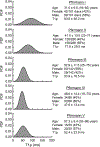ISSLS Prize in Bioengineering Science 2023: Age- and sex-related differences in lumbar intervertebral disc degeneration between patients with chronic low back pain and asymptomatic controls
- PMID: 36805320
- PMCID: PMC10205694
- DOI: 10.1007/s00586-023-07542-6
ISSLS Prize in Bioengineering Science 2023: Age- and sex-related differences in lumbar intervertebral disc degeneration between patients with chronic low back pain and asymptomatic controls
Abstract
Purpose: Clinical management of disc degeneration in patients with chronic low back pain (cLBP) is hampered by the challenge of distinguishing pathologic changes relating to pain from physiologic changes related to aging. The goal of this study was to use imaging biomarkers of disc biochemical composition to distinguish degenerative changes associated with cLBP from normal aging.
Methods: T1ρ MRI data were acquired from 133 prospectively enrolled subjects for this observational study (80 cLBP, 53 controls; mean ± SD age = 43.9 ± 13.4 years; 61 females, 72 males). The mean T1ρ relaxation time in the nucleus pulposus (NP-T1ρ; n = 650 discs) was used as a quantitative biomarker of disc biochemical composition. Linear regression was used to assess associations between NP-T1ρ and age, sex, spinal level, and study group, and their interactions.
Results: NP-T1ρ values were lower in cLBP patients than controls (70.8 ± 22.8 vs. 76.4 ± 22.2 ms, p = 0.009). Group differences were largest at L5-S1 (ΔT1ρcLBP-control = -11.3 ms, p < 0.0001), representing biochemical deterioration typically observed over a 9-12 year period (NP-T1ρ declined by 0.8-1.1 ms per year [95% CI]). Group differences were large in younger patients and diminished with age. Finally, the age-dependence of disc degeneration was stronger in controls than cLBP patients.
Conclusion: Aging effects on the biochemical composition of the L5-S1 disc may involve a relatively uniform set of factors from which many cLBP patients deviate. NP-T1ρ values at L5-S1 may be highly relevant to clinical phenotyping, particularly in younger individuals.
Keywords: Aging; Chronic low back pain; Disc degeneration; Lumbar spine; T1ρ (T1rho) magnetic resonance imaging (MRI).
© 2023. The Author(s).
Conflict of interest statement
Declarations
Figures





References
Publication types
MeSH terms
Grants and funding
LinkOut - more resources
Full Text Sources
Miscellaneous

